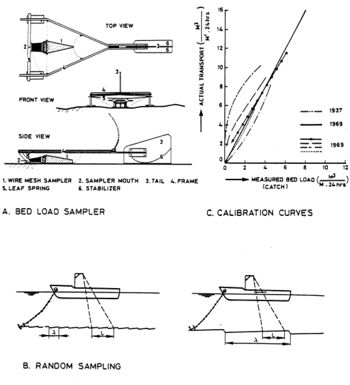Bed load transportmeter Arnhem (BTMA)
This article is a summary of sub-section 5.5.1.2 of the Manual Sediment Transport Measurements in Rivers, Estuaries and Coastal Seas [1]. This article describes the use and working of an instrument to measure bed load transport, the Arnhem sampler.
Contents
Introduction
The instrument is based on the collection of sediment particles by means of a basket type sampler. The basket, consisting of fine wire mesh and mounted in a frame, is pressed (by means of a spring) on the channel bed after lowering of the frame (Figure 1). The form of the basket causes a pressure reduction behind the instrument so that the water and sediment particles enter the mouth of the basket with the same velocity as that of the ambient flow, provided that the sediment content, already in the basket, is relatively small. The sampler can collect particles coarser than 0.3 mm (mesh size basket) but finer than 50 mm (opening height).
Before starting a series of measurements, an echo sounding of the longitudinal bed section at the sampling location must be made to determine the bed form length. If the bed form length (dunes) is large compared with the boat length, the sampling location must be changed regularly in longitudinal direction to assure random sampling (Figure 1) and at least 20 samples should be collected. The sampling time may be larger than 2 minutes but never larger than the time needed to fill the sample basket for about 40% of the capacity. It is sufficiently accurate to determine the immersed volume of the sediment catch on board of the vessel by using a calibrated funnel. Single samples should be returned to the laboratory to determine the porosity factor of the samples.
The bed load transport (in kg/sm) can be determined as: [math]S_b=\alpha\,(1-p)\rho\,_s V_s\,/(bT)[/math] or [math]S_b=G_s\,/(bT)[/math]
in which:
- [math]\alpha\,[/math] = calibration factor,
- [math]p\,[/math] = porosity factor (= 0.4),
- [math]\rho\,_s[/math] = density of sediment particles (= 2650 kg/m3),
- [math]V\,_s[/math] = immersed volume of sediment catch (m3),
- [math]G\,_s[/math] = dry mass of sediment catch (kg),
- [math]b\,[/math] = width of intake opening (= 0.085 m),
- [math]T\,[/math] = sampling period (s).
Calibration
The accuracy of the measured bed load transport is strongly dependent on the accuracy of the calibration factor, the number of measurements and the sampling procedure (skilled personnel). Assuming ideal sampling, at least 20 samples must be collected at each location to obtain a bed load transport rate with a standard deviation (error) of about 20% (De Vries, 1973[2]). In practice the sampling error will be considerably larger (say 100%) particularly due to the sampling procedure (see also Hubbell et al. 1985[3]).
See also
Summaries of the manual
- Manual Sediment Transport Measurements in Rivers, Estuaries and Coastal Seas
- Chapter 1: Introduction, problems and approaches in sediment transport measurements
- Chapter 2: Definitions, processes and models in morphology
- Chapter 3: Principles, statistics and errors of measuring sediment transport
- Chapter 4: Computation of sediment transport and presentation of results
- Chapter 5: Measuring instruments for sediment transport
- Chapter 6: Measuring instruments for particle size and fall velocity
- Chapter 7: Measuring instruments for bed material sampling
- Chapter 8: Laboratory and in situ analysis of samples
- Chapter 9: In situ measurement of wet bulk density
- Chapter 10: Instruments for bed level detection
- Chapter 11: Argus video
- Chapter 12: Measuring instruments for fluid velocity, pressure and wave height
Other internal links
External links
Further reading
- Delft Hydraulics, 1958. Calibration of BTMA (in Dutch) Report M6Q1-I, The Netherlands.
- Delft Hydraulics, 1966. Development of Bed Load Samplers (in Dutch) Report M601-II, The Netherlands.
- Delft Hydraulics, 1969. Calibration of Bed Load Samplers (in Dutch) Report M601-III, The Netherlands.
References
- ↑ Rijn, L. C. van (1986). Manual sediment transport measurements. Delft, The Netherlands: Delft Hydraulics Laboratory
- ↑ De Vries, M., 1973. On Measuring Discharge and Sediment Transport in River Flow. Delft Hydraulics Laboratory, Publication No. 106, The Netherlands.
- ↑ Hubbell.D.W., Stevens, H.H., Skinner, J.V. and Beverage, J.P., 1985. New Approach to Calibrating Bed Load Samplers. Journal of Hydraulic Engineering, Vol.111, No.4.
Please note that others may also have edited the contents of this article.
|
Please note that others may also have edited the contents of this article.
|
